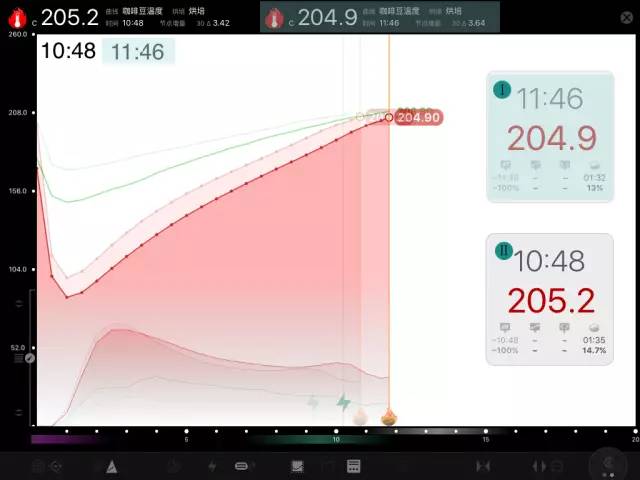Coffee roasting from a physical point of view
Follow the caf é (Wechat official account vdailycom) and found that Beautiful Cafe opened a small shop of its own.
1. Color deepening
The color of coffee beans changed from yellowish green to light brown, and then gradually to brown, brown and dark brown. This is because the starch in raw coffee beans is converted into sugar, which is further coked. The change of color is the most easily observed phenomenon of coffee roasting, so people describe it the most. Until there was a standard: the baking degree analyzer invented by Agtron Inc in the United States determines the current standard roasting degree of coffee beans by emitting and receiving light on the surface of coffee beans. The deeper the roasting degree, the darker the color of coffee beans, the stronger the light absorption, the weaker the reflected light, and the lower the Agtron value. On the contrary, the lighter the baking degree, the lighter the color of coffee beans, the weaker the light absorption, the stronger the reflected light, and the greater the Agtron value. Baristas can determine the degree of baking through a standard baking color swatch. It is important to note that Agtron baking color value is only one of the auxiliary baking technologies, but can not do more. Two portions of the same coffee beans are roasted to the same Agtron baking color value, but due to the difference in the baking curve, there will be different flavor characteristics and sensory experience. Professional baking needs not only to compare the color, but also to smell the aroma, listen to the explosion, calculate the time, analyze the curve and other methods to be used comprehensively.

two。 Lose water and lose weight
Coffee beans are rich in water, which is divided into free water in free state and bound water locked in cells and adsorbed with organic solids, which is a component of coffee bean cells and a good solvent. In the process of coffee roasting and heating, the weight of coffee beans is reduced by 10% and 15% from free water to combined water. The reason why coffee cooked beans are much more expensive than raw coffee beans, in addition to the substantial increase in the investment in the roasting process, weight loss caused by water loss is also one of the reasons.
3. Volume expansion
With the roasting of coffee, heavy gases such as carbon dioxide begin to spill out in large quantities, and the pressure inside the coffee beans can even reach 20-25 atmospheric pressure, which will cause the coffee beans to expand by 25%, 60%, like popcorn. 4. With the progress of coffee roasting, the original compact fiber structure expands and changes, forming a large number of holes that can be seen under the microscope. Carbon dioxide and volatile aromatic substances escape along these irregular channels, making the original dense and solid coffee beans more brittle-if observed under a magnifying glass. You can see obvious characteristics of sponge, activated carbon or honeycomb structure-oxygen can also invade through these channels, quickly deteriorating the flavor of coffee.
Important Notice :
前街咖啡 FrontStreet Coffee has moved to new addredd:
FrontStreet Coffee Address: 315,Donghua East Road,GuangZhou
Tel:020 38364473
- Prev

One cup of coffee and two curves
This time we were in a playful state of mind and did a test across time and space, and the results were not bad from the feedback results, the friend joked. You are going to open up a new world of cup testing (network cup testing). It's funny. A total of 37 copies of this event have been sent out, plus I am now drinking some friends to test, I believe that there should be more than 60-70 people playing this game. Straight
- Next

Espresso stems from superb roasting techniques.
Following caf é (Wechat official account vdailycom) found that coffee roasting is like magic, turning cyan beans into dark brown, fragrant coffee beans! So the roasting of coffee is the key factor to determine the quality of coffee! Specifically, during the coffee roasting process, the heat is slowly transferred to the beans. In the high temperature
Related
- Beginners will see the "Coffee pull flower" guide!
- What is the difference between ice blog purified milk and ordinary milk coffee?
- Why is the Philippines the largest producer of crops in Liberia?
- For coffee extraction, should the fine powder be retained?
- How does extracted espresso fill pressed powder? How much strength does it take to press the powder?
- How to make jasmine cold extract coffee? Is the jasmine + latte good?
- Will this little toy really make the coffee taste better? How does Lily Drip affect coffee extraction?
- Will the action of slapping the filter cup also affect coffee extraction?
- What's the difference between powder-to-water ratio and powder-to-liquid ratio?
- What is the Ethiopian local species? What does it have to do with Heirloom native species?

